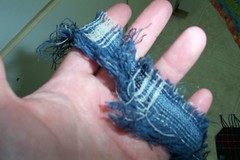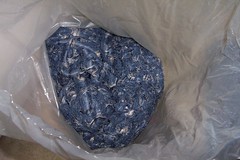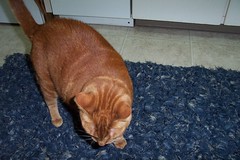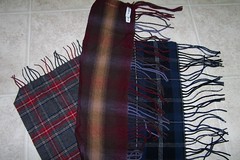We made them from waste from Pendleton Wool fabric. How awesome is that?
These are the selvedges from the fabric looms – where the threads are attached to the framework of the looms as the fabric is being made. When the bolt of fabric is finished, workers just slice the fabric off the loom, leaving these edges. For years and years, these ends were just swept up into the trash. Eventually, someone figured out that these edges were useful to rugmakers and other crafters, and the mills began selling them in big bags. My bag here is about seven pounds of worsted wool. At the store, you can find great big wooden bins full of sacks of selvedge scrap – I saw bags 6-15 pounds, all in the same colors as the fabrics coming out next season, and when I was in the store, they all cost $3 per pound.

So my rug is made from the exact same fabric as next season’s men’s shirts, for somewhere around a third to a quarter of the cost of the shirt. And it’s all made from fabric-making waste.
Stacey, who led the class, said the store gets shipments of these bags every Friday, and “it’s like the running of the bulls” with craftsters gathering up everything they can find to make rugs, hats, bags, whatever. The shipments are even announced on the Pendleton Woolen Mills blog.
The selvedges & blanket ends and all the other waste for sale in the bins used to just be shipped off to the landfill. Gah!

It was a pretty quick rug to make. It’s about 3 x 4.5', took about 6 of the 7 pounds of selvedge I'd brought home, and it took me about six hours to make. That’s including breaks for petting the kitties who were DETERMINED to umhelp.
Hookers' note: it was all done in SC with a Q hook

The finished rug.

The rug being put through rigorous testing by the QA department.
After the class, I got to poking around the store a bit. Underneath all those tables of fabulous fabrics and wonderful blankets and everything else? More bins of waste! Among which I found some blanket ends that should make terrific scarves! And I didn’t even have to do anything to them. They were already the right length & width, already fringed, and already great colors. These are just the ends of the blanket fabric as the blankets are cut to length for sale.

These blanket ends are already on their way to a friend to become scarves. Or maybe they’ll get cut up and used as patches on other wool items. Or patched together into a wool quilt. Or turned into little wool stuffed animals. There’s no telling! (Though I hope she does eventually tell me!)
Fun facts about wool*
-wool is naturally flame-retardant. If I ever have a fire in my house, I can use my rug to smother it.
-wool is naturally durable. Wool resists tearing and it can bend back on itself 20,000 times without breaking. Cotton breaks after only 3,200 bendings, silk fibers after just 1,800, and rayon fibers after just 75 bends.
-“unless soiled, most wool garments and blankets require cleaning only once or twice a year”
-wool is naturally resistant to mildew & mold, which comes from the way wool repels moisture
-wool is also resistant to static electricity
-wool is actually naturally hypo-allergenic. While a few people have a rare allergy to lanolin, the oil found in wool, most people’s “allergy” is actually a sensitivity to the “poking” that individual wool fibers can do to the skin.
*Fun facts taken from these sources:
Pendleton Woolen Mill’s “Wool… A Natural” booklet
OrganicClothing.blogs - Wool: Facts behind the fiber
American Sheep Industry Association
Other reduce/reuse/recycle info from Pendleton Woolen Mills
That's a great way to recycle!
ReplyDeleteThanks for visiting my blog!
This is a really great blog! I admire your interest in re-using and recycling. Do you have any use for several Pendleton wool shirts (4 or 5 of them)? We found them at my father-in-law's house after he passed away. Unfortunately, moths had gotten to them, so nobody would be interested in wearing them. I'd be willing to send them to you after washing them if you are interested in using them for a rug project.
ReplyDeleteLinda
thanks for the great post. did you felt your rug after crocheting it? have you heard of anyone doing this?
ReplyDeleteI've washed it a couple of times (the cat decided to comment negatively on it after it was put to use) and it hasn't really felted up. It may be due to the way the fibers are laid out, already being part of a material. I used blanket ends so the fibers may have done their felting before I got to them.
ReplyDelete